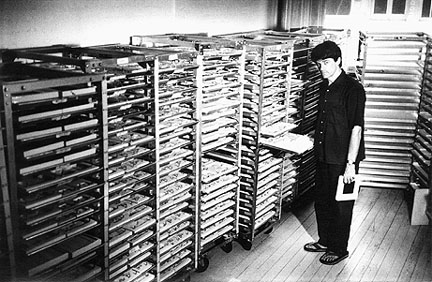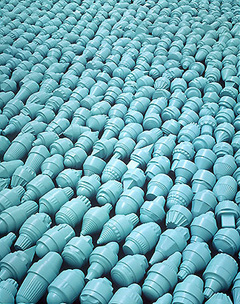
|
|
ALLAN McCOLLUM
February 26, 1991, in SoHo.
(Excerpted from the beginning of an audiotaped transcription of a talk that took place as part of the annual Independent Curators International benefit series "New York Studio Events")
|
|
Allan McCollum, in his studio, 1989. New York City, NY.
| |
|
I've always been interested in the distinction between the unique object, such as the artwork, and the mass-produced object, such as something industrially produced. I've always felt that the distinction we make between the two isn't as understood as it could be. Our understanding of uniqueness is only arrived at by comparing the unique object to an object that isn't unique. So it might make sense to say that the unique object is created by the mass produced object. The problem in these distinctions interests me.
The "Constructed Painting" series, of 1969 to around 1975, for instance, resulted from my thinking about what might determine the identity of an art object in this context. I was influenced by the quasi-critical distinctions art writers used during that period, and I tried to turn them into a kind of mass production system. The works were made from standardized canvas or paper shapes that I would make by the hundreds, sometimes by the thousands, and glue together using various task-oriented systems, making repeated patterns, like complicated tile work. So one wasn't able clearly to say whether or not these were art objects: they weren't exactly produced the way art objects were, but then again they sort of satisfied the conditions one thought of for a formalist artwork, all lines and edges, all self-referring. They became, in my mind, surrogate artworks.
I continued to develop the idea of an artwork as an imitation of an artwork. I began to question where that investigation might lead: I wanted to understand what an artwork was in terms of the other objects in the world. To the degree that I was interested in definitions at all, I became more interested in the more anthropological definition of an artwork. I mean, if one imagined a continuum of paint being applied to a surface, and at one end of the continuum is a fire hydrant and at the other end is a de Kooning, where in that continuum would one find the brush mark that you weren't quite sure was an art brush mark or a coating? I found this a scary sort of place. I was interested in a painting that you weren't sure was an artwork or not. I then realized that an artwork is largely something that fits in a categorical place where we expect to find artworks. There is a system of objects, in a sense—objects that are chairs, objects that are food, objects that are pets, objects that are paintings. And artworks achieve their identity by occupying a place in that system.
To investigate this I decided to come up with an art object that functioned like a sign tor an art object. When I tried to think about a painting, I could only think of, say, a Picasso or Cezanne. No neutral image of a painting that was just a painting would enter my mind—so I decided to try to paint that painting. I wanted to promote a distanced view of an artwork, so that one might be able to think of it as an object in a world of other kinds of objects, like chairs and tables. I did a series of experiments in 1977, '78, trying to come up with a sign for a painting. The series title was "Surrogate Paintings."
During this period I had a job as an office cleaner uptown. Every night while I was cleaning the offices I would look out the windows and notice things in apartments in the faraway buildings that I immediately knew were artworks on the walls, but they were so distant I couldn't see any details beyond that. So part of my thinking was, How do I know that's an artwork? And obviously I knew because not only was it not a couch, but it had a frame, a mat, and something within the mat. I began to realize that this was the vocabulary one used when one identified a painting. And in the end, that collection of features was what I decided on—the frame, the mat, a window in the mat, and something flat and rectangular and anonymous inside the window—all of which, taken as a whole, could function as my sign for an artwork.
|
|
In a show in 1979, I put eighty of these "Surrogate Paintings" together in a cluster. It was hard to deny that there was something a little off about these works: they weren't exactly paintings, they were objects that represented paintings. I decided that maybe if I started giving them a black center, and articulating the frame with a slightly different color, I might make it more explicit that they weren't little Minimalist sculptures but signs representing paintings. One problem I had during this period was getting people to recognize that the frame and mat were parts of the work. It was almost impossible for people to understand that; they would point to the center and say, "Oh, this is the work here." At first I tried to counteract that by making the whole object monochrome, but in the end I had to come up with a technical solution: I took twenty of the "Surrogate Paintings," made molds from them, and began to cast them in plaster. Once I started doing that, I was able to make a lot more of them in less time—it had taken days to make them out of wood. So I was able to produce larger, more dramatic installations, and also to solve the question anyone might have as to whether or not the frame was part of the work. Once they were solid plaster, that question vanished.
In 1980, when I was designing the first "Surrogate Paintings," I decided also to devise a kind of sculpture that could function as a sign for a sculpture. So I began collecting different kinds of vases, and taking pictures of vases I saw on television. A vase is a symbol of civilization, or spirituality, or mortality, or femininity, or creativity—there's so much symbolism there. By casting vases solid, I developed a series that I called "The Perfect Vehicles." It was meant to evoke the kind of response one has to an object that one imagines might carry a transcendent meaning. These works, I decided, would start out with a neutral sort of presence, lacking in specific meaning. Over the years, though, they would develop an exalted presence. Sometimes when I look at them I feel they're functioning like spiritual vehicles. I think that will continue as time goes by.
|
| |

Allan McCollum. Over Ten Thousand Individual Works. 1987/88. Enamel on cast Hydrocal. 2 inches in diameter, lengths variable, each unique. To produce the Individual Works, hundreds of small shapes were collected from friends' homes, supermarkets, hardware stores, and sidewalks: bottle caps, jar lids, drawer pulls, salt shakers, flashlights, measuring spoons, cosmetic containers, yogurt cups, earrings, push buttons, candy molds, garden hose connectors, paperweights, shade pulls, Chinese teacups, cat toys, pencil sharpeners, and so on. Rubber molds were created from these shapes to produce a vocabulary of forms that could be combined in hundreds of thousands of different ways. An arithmetic system was used to insure that no two Individual Works would be alike.
|
In 1987 I began a series called "Individual Works," which addressed the notion of the unique versus the mass produced object probably more than any other series did. I developed a system for producing thousands of little plaster shapes, about the size of your hand, each one being completely unique. My inspiration was those little objects by Steuben or Fabergé objects with no purpose except to be symbols of value. I thought it would be interesting to operate as an artist who saw no distinction between a plaster souvenir and a Fabergé egg. What kind of object might I design if I didn't recognize that distinction? I was also interested in why we divide up the world of objects into categories of, say, the mass produced object, which is common and interchangeable, and the rare and unique object. It occurred to me that it would be simple to mass produce unique objects if one just decided that that was what one wanted to do. I felt the reason for not doing that must be ideological: we must enjoy this system in which there are many interchangeable objects and a few priceless ones. In a sense, this must reflect our view of the social world: the way we like to think of some people as special and others as expendable. I mean obviously it's ideological, not technological, because I could produce this system pretty easily, and I'm not an industrial designer, I'm not a production engineer—I just worked in my kitchen with little things I found in hardware stores and supermarkets, flashlights and doorknobs and bottle caps and stuff like that, and I made a point of never using a computer or anything complicated. I made molds in my kitchen, then made casts from those molds and developed a vocabulary of shapes. I had tables filled with these little parts, and I chose ones that I liked best. I've made enough molds at this point to produce about 48,000 unique objects. I've so far produced about 25,000.
We have a hard time coming to terms with huge numbers. When we think of a huge number of objects, it's comforting to imagine that they're all alike. But to imagine a huge number as all different—to think of a people we're at war with, for instance, as all unique individuals—is painful. To make distinctions among huge quantities of things we've been thinking are the same, to suddenly have to look at them as unique this is a painful disruption of our way of perceiving the world. So having all the objects in "Individual Works" in front of us makes us go through this battle. There are over 10,000 unique objects here—does it matter that they're unique? Are they symbolic of the world as a whole, because all people are unique? Or would I prefer to think of people as not unique? This series triggered a lot of that kind of moral consternation.
|